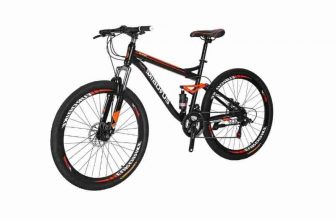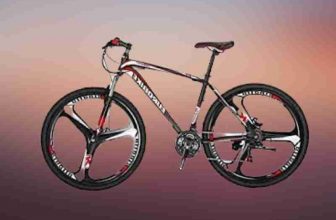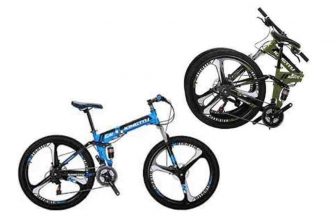
Today, there are so many options available for bikes on the market. The various types of bicycles are designed to cater to the specific needs of cyclists, whether it is a bikeable to handle crowded streets or one which can handle steep inclines with ease.
It can be intimidating to shop for a new bike if you’re new to cycling and don’t know where you’ll enjoy riding. There is something special about every type of bike, whether a cruiser bike or a hybrid.
What ultimately matters is where you ride the most. A mountain or a hybrid bike is a popular choice for first-time cyclists because of its adaptability. But when it comes to hybrid bike versus mountain bike, the ideal option isn’t always evident, especially if you require a bike that can manage off-roading and commuting.
If you’re deciding between a hybrid bike and a mountain bike, consider your riding style, the terrain you prefer, and the purpose for which you’ll be using the bike. The mountain bike is the best choice if you want a bike for some off-roading action over the weekend.
On the other hand, if you want a bike that can handle daily commuting and moderate off-road riding at the weekend, then a hybrid bike is the way to go. However, if you’re looking for something that can be used for many types of bikes, the hybrid bike is preferable.
The hybrid bike is the best option for the modern cyclist who wants to do some off-roading on the weekends, get good exercise in the morning, and then ride their bike to commute to work.
A hybrid bike and a mountain bike have some similarities in their design, and they each thrive in different environments. While the mountain bike is better suited to off-road riding and technical terrain, the hybrid is better suited to speed and maneuverability.
Most cyclists prioritize commuting and fitness, and only the hybrid bike can give both durability and quality, two critical features that decide just how long your bike will survive with frequent use.
The Design of a Hybrid
Combining mountain biking with road biking, a hybrid bike is known as a hybrid bike. They are frequently designed with a more relaxed posture in mind, making it easier for cyclists to take a more comfortable position while riding long distances.
These bikes also offer high gear ratios for more effortless pedaling and shifting. Most versions will come with thinner tires, just like a road bike designed for speed. However, certain types sport thicker tires, just like a regular mountain bike.
A hybrid bike’s smaller weight and faster speed make it a better choice for commuting and leisure use than a mountain bike. Mountain bikes are not recommended for long trips if you’ve ever commuted to work on one.
Most mountain bikes are built out of stainless steel. Combined with the thick, robust tires, you’re looking at a bike that’s tremendously hefty, too much to carry up to one or two severe slopes. Because they’re built for a tougher ride, mountain bikes are typically more expensive than normal hybrids.
Due to their design, these bikes are not considered good commuters, especially since they have knobbed tires and a lower gear ratio.
However, the hybrid is very efficient for commuting needs and is equipped with quicker tires and a more suitable gear ratio for long trips.
To understand more about hybrid bike design, click here to read our buyer’s guide.
Doing It My Way
Mountain bikes are designed to ride technical paths surrounded by obstacles such as potholes, rocks, gravel, logs, and branches. Compared to the hybrid, these bikes have a significantly more aggressive frame geometry, allowing the rider to climb and pedal more effectively.
The lower gear ratio on a mountain bike is designed to make it easier for the biker to pedal across challenging terrain. Since mountain bikes are mainly designed to handle hard terrain smoothly, these bikes have a very durable design equipped with severely knobbed tires and top-of-the-line suspension.
Off-roading can be risky, and a hybrid is not equipped with the proper suspension.
There are various styles of mountain bikes to pick from. While the normal trail mountain bike is designed for off-road use only, some models, like the cross-country type mountain bike, are developed for speed upwards.
Both mountain bikes come equipped with full suspension and a lower gear ratio.
Mountain bikes and hybrids: the key differences
Frame
Visually, mountain bikes and hybrid bikes can be distinguished by their frames. A hybrid bike has a frame that is more similar to a road bike than a mountain bike.
The frame is smaller and lighter than on a mountain bike because it isn’t anticipated to withstand the same conditions.
Combining these elements allows the hybrid bike frame to be lighter than those seen in mountain bikes. In addition to the lessened weight, they offer a more aerodynamic shape that makes them more efficient for road riding.
While crucial in road cycling, the factors of weight and aerodynamics play a much smaller role in mountain biking. The need for lightness pales in comparison to the importance of a strong frame.
Amount of suspension
We can distinguish hybrid and mountain bikes based on the suspension, or lack thereof, after the frame.
Suspension on the bike is unnecessary for a hybrid, intended to spend most of its time on paved roads.
Their lower tire pressure and bigger tires help them endure road bumps that could otherwise be bothersome on a road bike.
Suspension not only makes the bike heavier but also increases its price. As a result, the suspension is uncommon on hybrid bikes.
To make them more trail-friendly, you may find certain hybrid bikes with a simple front suspension. The suspension, however, is often not up to the standards of a mountain bike.
Hybrid suspensions are often made with lower-quality components and have significantly less travel than conventional systems to save weight and money.
Brakes
In contrast to disc brakes, which are found on some hybrid bikes, classic rim brakes are used on most of these bikes. In addition to being lighter, cheaper, and easier to replace, rim brakes are also easier to estimate wear.
Many hybrid cyclists will use their bikes for short trips to and from the bike or fun. Since most of their routes are relatively flat, the added power of disc brakes is frequently unnecessary.
Since weight is less of a consideration for mountain bikes, they always employ disc brakes. Even at a low price point, a mountain bike without disc brakes might be found at a large department shop, although this is quite rare.
A disc brake’s increased stopping power is also beneficial to mountain biking, where rim brakes may not be powerful enough to stop you during steep descents.
Gears
There are a variety of conditions mountain bikes will face on the trail. There’s a lot to deal with, from easy flats steep downhills to tremendous climbs. For this reason, mountain bike gearing typically includes a wide range to help a rider navigate these diverse conditions.
On the other hand, hybrids are more likely to be used on flat(ish) roads with occasional hills, so they don’t require the same range of acceleration and deceleration to support the rider. You will also carry less weight if you have fewer gears, which will help you drive more efficiently.
There’s nothing unusual about hybrid bikes having only one speed. Nevertheless, there won’t be too many of these in San Francisco.
Tires
Whether it’s dry, wet, or somewhere in between, mountain bikes come with big, beefy tires laden with knobs to provide better traction. On the other hand, these huge tires can slow you down on the road.
Those knobs and greater width produce more friction and slow you down on paved roads. As a result, hybrid bicycles have smoother, thinner tires. This lowers their rolling resistance, allowing them to travel faster.
The tires on hybrid bikes are thin but nowhere near as thin as those on mountain bikes. There will be no problems with mud or gravel trails despite the additional width. As a result of their wider frame, they can also enjoy better comfort when riding on the road compared to road bikes.
The tire pressure for hybrid bikes is also different from road or mountain bikes. Here is a graph comparing the two to illustrate the differences.
In general, the tire pressure of hybrid bikes is somewhere in between that of mountain bikes and that of road bikes. It makes more sense for proper tire pressure based on tire width.
Last but not least, mountain bike tires differ in size from their hybrid counterparts. Hybrid bikes typically have 700c tires (*28 inches), just like road bikes.
Sometimes you’ll also see 26-inch tires, but 700c is the standard. By comparison, most new mountain bikes are running 27.5 or 29-inch tires these days.
Fenders and cargo racks
Many hybrid bikes are equipped with fenders and load racks because commuters commonly use them. Both are certainly beneficial to hybrids, although neither is a “requirement.”
If you’re riding your bike to work, the last thing you want is mud and water getting on your work clothes. Fenders assist avoid this mess from occurring and preserve you from needing to change clothing when you get to work.
Even if it lacks fenders, a hybrid bike can be used for commuting. In case of bad weather, it’s a good idea to have a spare set of clothes on hand!
Fenders are less prevalent on mountain bikes; however, you may see some individuals using them depending on your area or the season. Fenders can assist you in avoiding some of the mud and filth that gets thrown up on wet trails, much like they do for practical commuters.
The addition of cargo racks to some hybrid bikes can be helpful for both commuting and doing errands around town. As an alternative to holding your products while riding, you can strap them onto the back of the bike and keep both hands on the handlebars.
Most factory mountains do not come with cargo racks, but aftermarket racks are available. You could install a cargo rack on your mountain bike if you’re using it for commuting.
Cargo racks are an option for those who want to go on adventurous bike packing journeys. You can carry your belongings safely and securely during long-distance rides using bike-specific saddlebags called panniers.
Handlebars
Although there are exceptions, flat or riser handlebars are common on most hybrid and mountain bikes.
Due to their heavier road use, certain hybrids may have drop or mustache bars to make for more effective road riding.
These aren’t standard features on mountain bikes, so you’re unlikely to see them.
Seats
The performance of hybrids is less critical since they are typically used in casual and fun situations. Indeed, comfort is a significant factor in the existence of hybrids.
As a result, broader, more comfortable seats are standard equipment on many hybrids. No padded shorts or chammy needed 🙂
With performance being crucial for many mountain bikers, their seats are often more aggressive for performance reasons.
What is a hybrid bike useful for?
The name says it all – “hybrid.” A wide range of riding conditions is well-served by hybrid bikes. As a result of their mid-range bike, hybrid bikes are equally at a mountain on the road as they are in the mountains.
Commuting to work and a fast ride into town or around the neighborhood are great settings for using a hybrid bike. Despite being designed for comfort, these bikes can handle a wide range of terrain with ease.
As a means of staying fit, hybrid bikes let you spend a long time in the saddle while providing a more pleasurable ride. In the case of an injury history or if you are over 40, you might benefit from riding a mountain bike instead of a road bike.
Although a hybrid bike is, in essence, the jack of all trades, it is unlikely to excel at anything in particular. Using a hybrid bike is not a good idea if you ride the road a lot or cycle competitively.
That’s not to suggest that it won’t get the job done, simply that you won’t see ever see somebody winning the Tour de France on a hybrid bike.
The same is valid for off-road riding puts a lot of stress on the body. Hybrid bikes have larger wheels and more robust frames than road bikes, but they are the greatest choice for off-roading in the woods or on bike roads.
You can use it on smooth gravel or dirt trails, but if you add pebbles, roots, or any other major obstacles, things will fall apart (literally).
As most hybrid bikes do not have suspension, you are unlikely to ride very far on rocky trails on tires.
The lack of suspension and reduced puncture resistance is just asking for flat after flat. Using a mountain bike is much more suitable at this point.
Hybrid vs mountain bike for commuting
Most commuters will utilize a hybrid bike instead of a mountain bike. Using a hybrid bike, you may use the greatest aspects of both a road bike and a mountain bike.
The more relaxed attitude of a hybrid makes it more comfortable than a traditional road bike for short commutes. Additionally, the bigger tires on this vehicle make it easier to navigate less-than-ideal road conditions and minor obstructions.
You may certainly commute on your mountain bike, but a hybrid will be a superior option in most cases. If your commute comprises particularly difficult roads or trails, then a mountain bike may be a better alternative for you.
See my article for additional information about riding a mountain bike on the road.
Are hybrids faster than mountain bikes?
Depending on one’s riding circumstances, the answer to this question varies widely.
A hybrid is unquestionably the better choice when it comes to road riding. Its tires provide reduced rolling resistance on the road, allowing your pedal strokes to translate into more distance covered.
Its frame is also smaller, lighter, and more aerodynamic, all of which improve your riding efficiency.
Drop bars, which enable a more aerodynamic riding position on some hybrid bicycles, are also available. Their high gear ratios allow them to reach and maintain higher speeds when driving on paved terrain.
Due to these reasons, a hybrid bike will be faster on the road than a mountain bike.
Mountain bikes will win hands down when comparing speed in a true off-road setting. It is very common for mountain bikes to have a suspension at least upfront, and many also have a suspension at the back, which can help you tackle difficulties you may encounter off-road.
Their larger knobby tires offer more traction and grip in slippery conditions. Furthermore, mountain bikes have gearing that is optimized for climbing steep hills.
Are Hybrid Bikes Good for Trails?
It depends on the trial. A hybrid bike has many options for trail types: dirt, gravel, and, of course, paved. In contrast, if there are a lot of potholes and obstructions on the trail, the hybrid will be challenging to maneuver. Since a hybrid lacks a mountain bike’s front and rear suspension, it’s dangerous to ride in rough terrain.
A Mountain Bike or a Hybrid: Which Is Better?
Off-road cyclists love mountain bikes because they can handle hills, rugged terrain, and winding trails, but the suspension systems make them heavier to ride.
Because hybrids combine the best features of both types of bikes, they are lighter than full-suspension mountain bikes. They’re normally prepared to be used on some off-road terrain, but they’re not perfect for full-on mountain riding.
Both bikes have their perks and limitations, so it depends on where you intend to perform the most of your riding.
Conclusion
Even though hybrid bikes are theoretically faster than mountain bikes, the differences are still minimal.
You will sacrifice some speed if speed is essential to you in any way if you use a mountain bike.
In my opinion, speed is significantly less important than comfort at this point, but I believe we’ve answered the key question logically.






